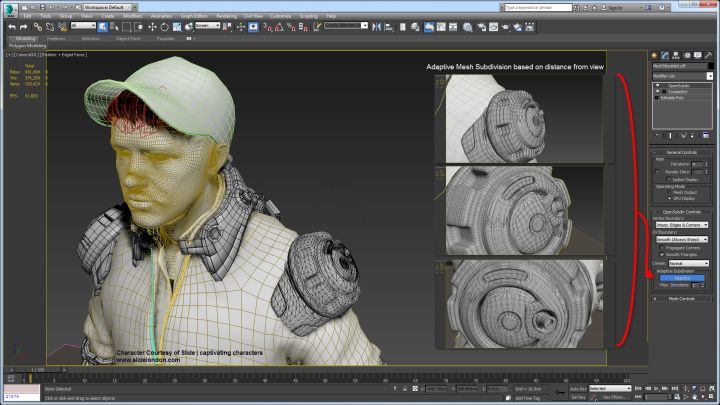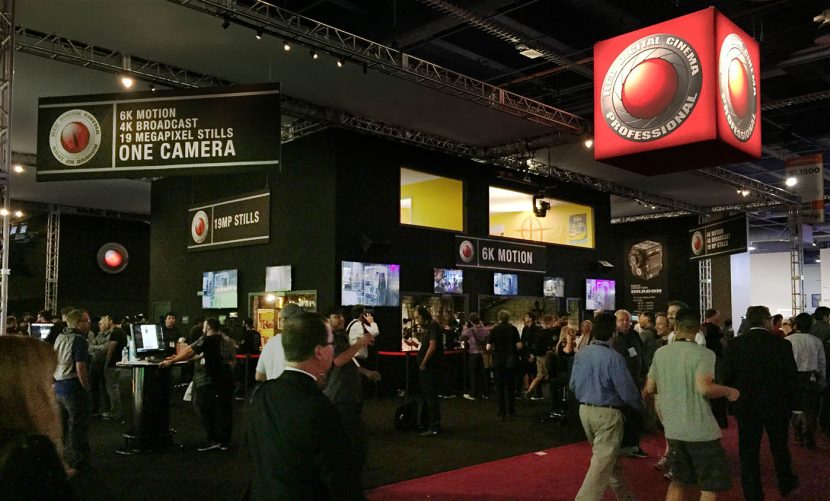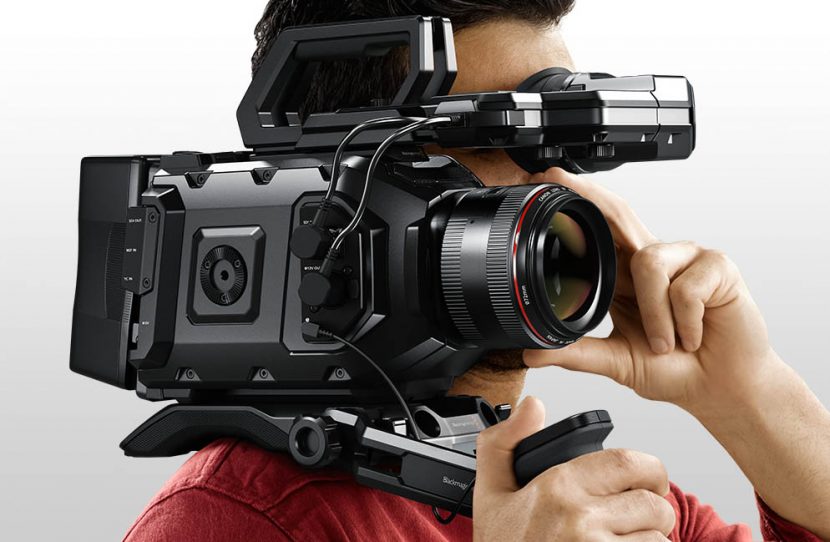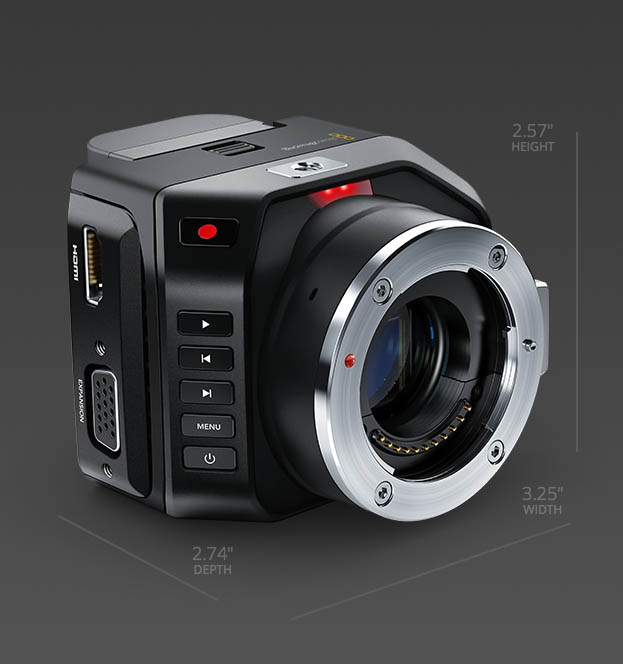NAB 2015 has begun! We will have more in-depth coverage as the week progresses, including in a special RC NAB podcast, but from the opening day of the show…here are some of the highlights.
PLUS Watch our for our special NAB RC podcast RSN (real soon now).
RED 8K
RED is showing the newest member of the RED DRAGON family. WEAPON combines new color science and great dynamic range from the 19 megapixel sensor. The RED DRAGON sensor with new built-in functionality is designed from the ground up to create a more intuitive shooting experience, according to the company.
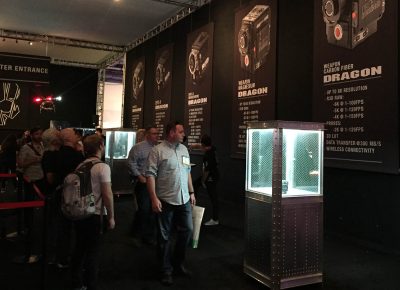 But the ‘biggest’ news – literally – is RED’s new 8K WEAPON option with a 8192 x 4320 sensor, or roughly bigger (just) than a standard full-frame 35mm sensor. The new 8K WEAPON will be an upgrade that is said to ship ‘at the end of the year’, but RED has a very bad track record on meeting shipping dates. In normal style there is a complex but fair upgrade path, but with a $10,000 discount if bought at NAB. The upgrade will cost $20,000 more than Carbon WEAPON after the show, (thus only $10,000 more if done during NAB). The final upgrade price will depend on which camera one is starting with. To make life really complex the pricing is quoted as ‘upgrade credit prices’ – so the CREDIT on an Epic-M Carbon Fiber is a whopping $22,500 done during NAB vs. the credit on a Scarlet Dragon after NAB of only $2,500.
But the ‘biggest’ news – literally – is RED’s new 8K WEAPON option with a 8192 x 4320 sensor, or roughly bigger (just) than a standard full-frame 35mm sensor. The new 8K WEAPON will be an upgrade that is said to ship ‘at the end of the year’, but RED has a very bad track record on meeting shipping dates. In normal style there is a complex but fair upgrade path, but with a $10,000 discount if bought at NAB. The upgrade will cost $20,000 more than Carbon WEAPON after the show, (thus only $10,000 more if done during NAB). The final upgrade price will depend on which camera one is starting with. To make life really complex the pricing is quoted as ‘upgrade credit prices’ – so the CREDIT on an Epic-M Carbon Fiber is a whopping $22,500 done during NAB vs. the credit on a Scarlet Dragon after NAB of only $2,500.
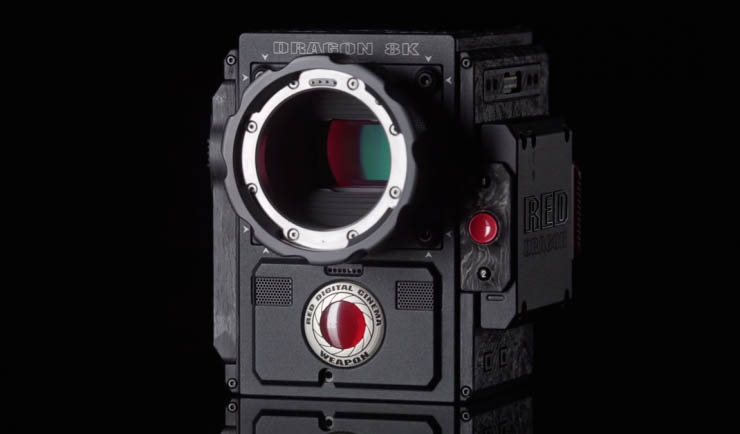 The more standard – if you can call it that – WEAPON Carbon Fiber 6K model will be around US$50,000 plus media and accessories. For the Magnesium, the main body / Brain is closer to $35,000.
The more standard – if you can call it that – WEAPON Carbon Fiber 6K model will be around US$50,000 plus media and accessories. For the Magnesium, the main body / Brain is closer to $35,000.
Most significantly RED has a ProRes recording option that simultaneously records with the R3D files. This is a really huge workflow improvement and will honestly impact more users than 8K recording, at least in the short term. The ProRes is 2K scaled down from the Sensor res and ranges from 120fps to 60fps depending on the camera body.
There is also a new enhanced Apple workflow. The ProRes option combines well with work RED has done with Apple and their FCPX. In addition to editing ProRes you can now edit your R3D footage faster than ever before with RED GPU acceleration for Final Cut Pro X, providing an enhanced workflow and improved speed. Initial user comments indicate that this new FCPX workflow is a significant improvement.
There is also what seems to be an excellent reference book RED DSMC Field Ops Guide as part of a RED Book Bundle for $75.
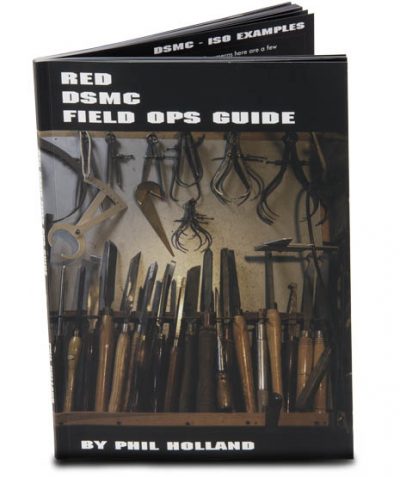 There are a few new books such as RED’s Rules of Engagement which is a hardcover book, as well as the Field Ops Guide, written by Phil Holland.
There are a few new books such as RED’s Rules of Engagement which is a hardcover book, as well as the Field Ops Guide, written by Phil Holland.
Rules of Engagement is a collection of educational resources for both photographers and cinematographers alike. Spanning concepts central to digital imaging and motion capture—Rules of Engagement is a comprehensive assortment of learning tools and reference information for all levels of expertise.
This custom-bound hardcover book represents the culmination of years of real-world application, white papers, online articles, and user feedback. It features over 220 pages of articles and shooting advice.
The RED DSMC Field Ops Guide is a comprehensive tool for shooters to quickly reference while on set, by Phil Holland who is a seriously respected member of the production community and an experienced DOP. Phil is based in LA where he works as a Director of Photography, Director, and Digital Imaging Specialist. He has been working professionally in motion pictures since 1999. With extensive experience working on large budget visual effects productions, he has a keen desire to stay on the bleeding edge of imaging technology, and a his field guide should prove highly valuable.
Blackmagic
Once again Blackmagic has aggressively hit NAB with a truck load of new and impressive tech.
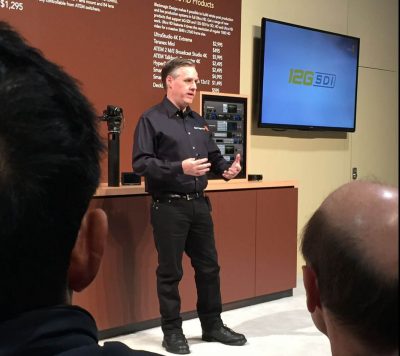 This year they have introduced an amazing new 4.6K image sensor with 15 stops of dynamic range for URSA cameras, three whole new cameras, a massive update to DaVinci Resolve, and a whole range of 12G-SDI products for broadcast, post production and live production.
This year they have introduced an amazing new 4.6K image sensor with 15 stops of dynamic range for URSA cameras, three whole new cameras, a massive update to DaVinci Resolve, and a whole range of 12G-SDI products for broadcast, post production and live production.
In total, Blackmagic’s Grant Petty introduced 38 new products today. While we are focused here on cameras it is worth noting that one great update in the range was for DaVinci Resolve 12.
The new DaVinci Resolve 12 has over 80 new features including multi-cam, 3D keying, 3D tracking, pro audio with third party audio plug-ins, parameters in the timeline, more trimming modes than before and much much more. Even its user interface has been refined and is more streamlined.
The new products shown include: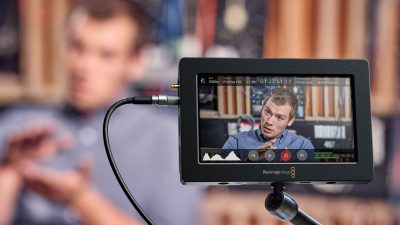
- Blackmagic URSA 4.6K Models
- Blackmagic URSA Viewfinder
- Blackmagic URSA Mini
- Blackmagic Micro Cinema Camera
- Blackmagic Micro Studio Camera
- DaVinci Resolve 12
- Blackmagic Video Assist
Plus…
– Teranex Mini 12G-SDI Converters
– ATEM Broadcast Studio 4K
– HyperDeck Studio 12G
– Smart Videohub 12G 40×40
– Smart Videohub CleanSwitch 12×12
– Fusion 8 Studio
– UltraStudio 4K Extreme
– DeckLink 4K Pro
New Blackmagic URSA 4.6K Cameras
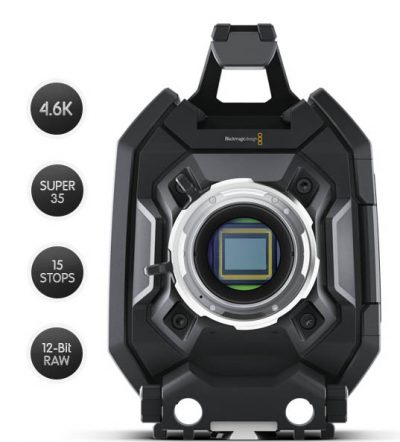 Commenting on the new cameras, Petty said, “When we introduced our URSA high end digital film camera last year, it was designed to be user upgradable. The reason for this is we had secretly been working on a whole new generation of sensor technology that we wanted all URSA customers to have, without obsoleting the camera. The great news is the millions of dollars we have invested in this new sensor have turned out wonderfully. It’s exactly as we hoped, the new sensor is 4.6K resolution and it has an amazing 15 stops of dynamic range. We have been shooting with the new sensor and have posted a video on the URSA page of our web site if you want to check it out.
Commenting on the new cameras, Petty said, “When we introduced our URSA high end digital film camera last year, it was designed to be user upgradable. The reason for this is we had secretly been working on a whole new generation of sensor technology that we wanted all URSA customers to have, without obsoleting the camera. The great news is the millions of dollars we have invested in this new sensor have turned out wonderfully. It’s exactly as we hoped, the new sensor is 4.6K resolution and it has an amazing 15 stops of dynamic range. We have been shooting with the new sensor and have posted a video on the URSA page of our web site if you want to check it out.
The new 4.6K image sensor features a Super 35 size with a resolution of 4608 x 2592 at 120 frames per second. With an extremely wide 15 stops of dynamic range it really rivals most traditional 35mm film stock.”
There are two models of Blackmagic URSA camera with the 4.6K sensor. The Blackmagic URSA 4.6K EF model will be available for US$6,995 and the Blackmagic URSA 4.6K PL will be available for US$7,495. Both 4.6K models will initially start with limited availability shipments in June and ramp up to full volume late July/August.
If you already own an URSA, then you will be able to upgrade to the new 4.6K sensor for $1,995 for the EF lens mount and $2,495 for the PL lens mount.
They have also reduced the price of the current shipping 4K models of Blackmagic URSA EF and PL cameras by $1,000.
Blackmagic URSA Mini
When launched the URSA was thought to be popular but heavy. Blackmagic has addressed this with the URSA mini.
The URSA Mini is a portable URSA based digital film camera, and while it does not have all the features of URSA, it has a lot and it uses the same sensors and core processing of URSA. It features magnesium alloy for its design so it’s very small and very lightweight which is perfect for portable and hand held use.
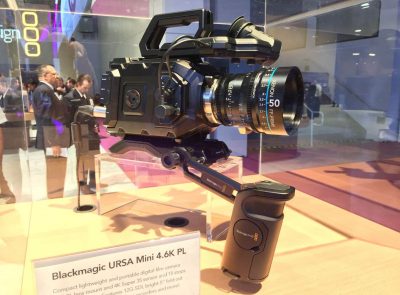 URSA Mini features the same 4K and 4.6K sensor options as URSA and is compatible with the new Blackmagic URSA Viewfinder. It features frame rates up to 60 fps, and it has a bright 5 inch full HD touch screen that folds out and angles. Like URSA, URSA Mini also has dual CFast card recorders so you can continue to record while changing cards and uses the same battery options.
URSA Mini features the same 4K and 4.6K sensor options as URSA and is compatible with the new Blackmagic URSA Viewfinder. It features frame rates up to 60 fps, and it has a bright 5 inch full HD touch screen that folds out and angles. Like URSA, URSA Mini also has dual CFast card recorders so you can continue to record while changing cards and uses the same battery options.
URSA and URSA Mini shoot the same looking images so you can easily use both cameras on the same shoot and intercut the shots.
There are 4 models of URSA Mini as there is two lens mounts and two sensor options. URSA Mini 4K EF is $2,995, URSA Mini 4K PL is $3,495. With the new 4.6K sensor, URSA Mini 4.6K EF is $4,995 and URSA Mini 4.6K PL is $5,495. URSA Mini will be available late July.
Blackmagic Micro Cinema Camera
The new Blackmagic Micro Cinema Camera is a miniaturized Super 16mm professional digital film camera with a new expansion port that lets you use PWM and S.Bus model airplane remote controls to operate the camera wirelessly.
The Blackmagic Micro Cinema Camera will be available in July for $995. At this price point it is aimed at a much wider market that includes say low cost radio control gear that hobbyists use for model aircraft and quadcopters.
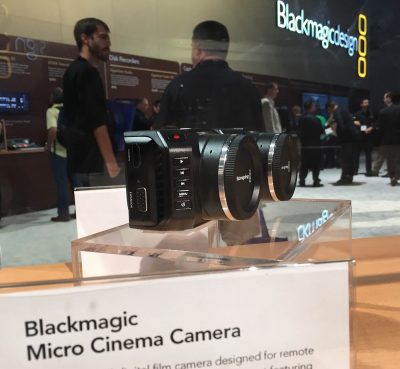 Normally these receivers plug into “servos” which generate movement when the user adjusts a knob on the hand held transmitter. These connections use a voltage called PVM and have the same connection on the Micro Cinema Camera. So this means you can plug into the camera and control the camera remotely.
Normally these receivers plug into “servos” which generate movement when the user adjusts a knob on the hand held transmitter. These connections use a voltage called PVM and have the same connection on the Micro Cinema Camera. So this means you can plug into the camera and control the camera remotely.
You can even map what camera feature you want on what channel, notes the company. So you could map the lens to adjust iris or focus. You could use a channel to start and stop recording, so you don’t fill the SD Card with RAW or ProRes files before you are ready for your shot!
To see what the camera is doing, it has a full sized HDMI connector and it even has composite NTSC/PAL out so you can use a low cost hobbyist video transmitter to see what the camera is doing and confirm its recording. Imagine having live feeds back from the camera when it’s in all kinds of hard to reach locations. “I think it’s going to be exciting to see where this camera is mounted and what kinds of shots it gets,” explained Petty at the launch.
It has an MFT lens mount so one can put all kinds of professional lenses on and adapt it easily to other lens mounts. The company claims the camera will have 13 stops of dynamic range.
“It is so cool in person – and just so small”
– fxguide’s John Montgomery from NAB 2015
Blackmagic Micro Studio Camera 4K
Grant Petty explained that the new Micro Studio 4K was born from the Micro Cinema camera: “With such a small Micro Cinema Camera design, we quickly realized that if we removed the built in recorder and digital film sensor cooling and replaced with SDI connections and a 4K video image sensor, we could build a really small studio camera for live production!”
The Blackmagic Micro Studio Camera 4K looks the same as the new Micro Cinema Camera but it’s a different camera because it provides for just $1,295 a broadcast quality Ultra HD studio camera.
Although one can use it with an external recorder as a production camera, it’s designed to be used in live production with a live production switcher. It has an Ultra HD sensor so it works in native Ultra HD.
Because it’s aiming to be a live camera, its features are almost identical to the Blackmagic Studio Camera 4K. It has SDI in and out, a built in color corrector and all the control to the camera can be sent via the SDI input so it uses the same SDI control protocol as Blackmagic’s studio cameras and ATEM switchers. It uses 6G-SDI, so supports all Ultra HD frame rates up to 30 fps, but it does 1080 HD frame rates up to 60 fps using the full sensor size.
This version of the camera has a PTZ serial connection out and this can be used for controlling a remote head. Any pan, tilt and zoom commands sent to the camera via SDI from the switcher will be output on this PTZ connection and if you have a zoomable MFT lens, it will adjust the zoom on the lens as well.
The Blackmagic Micro Studio Camera 4K will be available in July for $1,295.
GoPro
HEROCast was released allowing GoPro’s to work better in a live context.
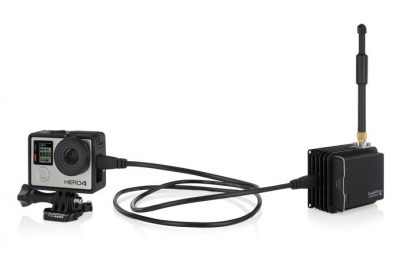 GoPro claim it is the smallest, lightest, and most cost-efficient wireless HD micro transmitter on the market. The company developed it in partnership with Vislink. The HEROCast transmitter enables professional broadcasters to deliver engaging, live content with immersive POV footage and unique perspectives that are synonymous with GoPro. HEROCast integrates with GoPro cameras and its ecosystem of mounts, and delivers versatile, mountable broadcast solutions by transmits high definition 1080/60fps and 720/60fps video using H.264 encoding with low glass-to-glass latency.
GoPro claim it is the smallest, lightest, and most cost-efficient wireless HD micro transmitter on the market. The company developed it in partnership with Vislink. The HEROCast transmitter enables professional broadcasters to deliver engaging, live content with immersive POV footage and unique perspectives that are synonymous with GoPro. HEROCast integrates with GoPro cameras and its ecosystem of mounts, and delivers versatile, mountable broadcast solutions by transmits high definition 1080/60fps and 720/60fps video using H.264 encoding with low glass-to-glass latency.
“GoPro is driven to enable people to capture their lives’ most important moments in the most immersive way possible, and it is that same motivation that has propelled the development of HEROCast. We want to change the way people see the events that are special to them. With HEROCast, broadcasters can bring their audience closer to their events than ever before, just as GoPro cameras have allowed people to uniquely share their lives with the people around them,” said GoPro President Tony Bates.
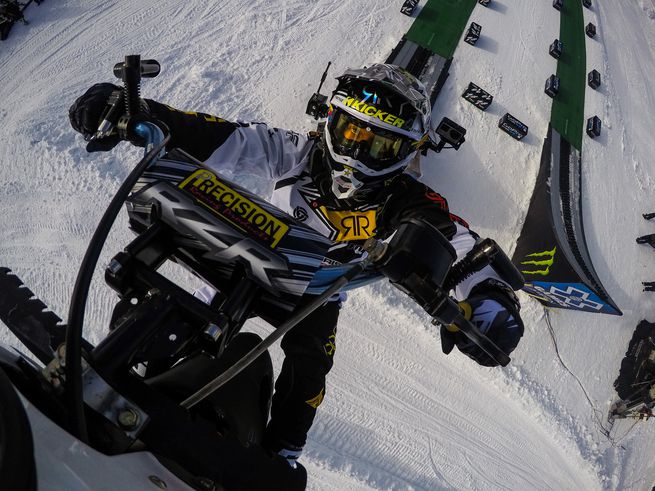
HEROCast is available as an independent unit that can be connected to your GoPro camera via a lockable HDMI cable, which is optimal for body mounting and POV shots. HEROCast BacPac directly connects to housing of a GoPro camera, delivering an integrated, water-resistant solution for immersive live action footage. Both configurations are compatible with HERO4 and HERO3+ Black cameras, carry up to an estimated 40 minutes of battery life (but they may also be powered externally for extended use), and deliver industry-standard wireless broadcast very cost effectively, claimed the company.
HEROCast $7,500 MSRP
- Optimized for body mounting and engaging POV shots
- Separate units for versatile mounting and easy accessibility
- Easily attached to GoPro mounts including Chesty and more
- Connects via [supplied] HDMI cable
HEROCast BacPac $7,500 MSRP
- All-in-one solution for immersive live-action footage
- Camera, transmitter, housing, and BacPac in one convenient unit
- Mounts to walls, cars, and other larger surfaces
- *Water resistant to IP67 specification
Drones
Drones continue to be a hot area of new innovation, amongst the huge number of options now available is this new SOLO GoPro Drone which features some new control software to greatly improve single operator use, over more complex dual operator systems.
The system has a 3-axis gimbal and onboard 1Ghz computer. The Solo’s on board computer allows it to do ‘smart shots’ such as ‘cable cam’ where you set both ends of a path and even the framing at the start and end of the move and the drone does the rest – with ease in and ease out and perfect interpolation – as if the camera was flying on a cable run instead of free flying.
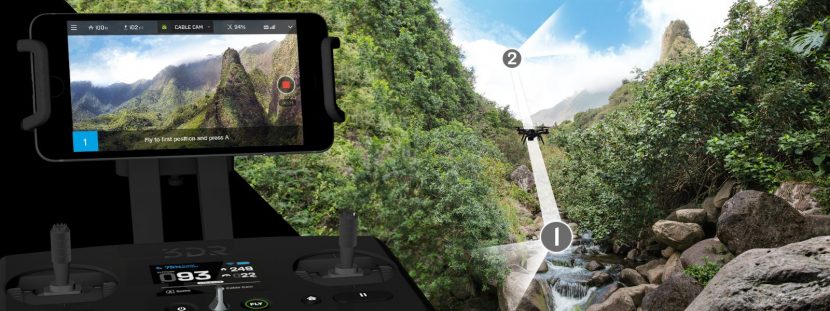 You can also lock the drone onto an object and get it to auto orbit the location. In Orbit mode the Solo will move on a circular track with an adjustable radius. You can fly around the point in circles in either direction and the Solo will keep the camera locked on your subject point. You can also adjust altitude and flight speed to create dynamic and sophisticated aerial shots… (allowing the ultimate in GoPro selfies!)
You can also lock the drone onto an object and get it to auto orbit the location. In Orbit mode the Solo will move on a circular track with an adjustable radius. You can fly around the point in circles in either direction and the Solo will keep the camera locked on your subject point. You can also adjust altitude and flight speed to create dynamic and sophisticated aerial shots… (allowing the ultimate in GoPro selfies!)
Very cool and totally left of field…
There is a new ‘camera’ solution, or perhaps package solution for outside broadcast that really caught our eye, – not for everyone but it is a great combination of VR, camera tech, cloud computing and lateral thinking.
Pixellot have produced a camera array that films an entire event – with one rig, and then stitches it together. The result: instead of needing multiple camera operators at a sporting ground – you have one – who sends a mega set of connected images back allowing for seamless stitching of the entire event. Then back at your office or broadcast hub you can zoom, cut, replay or split screen the action.
Founded in 2013 by Dr. Miky Tamir and Gal Oz, Pixellot provides a unique, high-quality and affordable alternative to traditional video capture and OB van production processes, opening the way to a new approach to outside broadcast for sports events. Prior to Pixellot, Tamir and Oz co-founded SportVU, a company that developed a vision-based statistics data generation system for sports events.
Pixellot has invented and developed effectively a super ultra high resolution ‘virtual camera – an unmanned video capture system with a remote proxy video production suite. This novel solution effectively automates video production by deploying a multi-camera system that covers an entire scene.
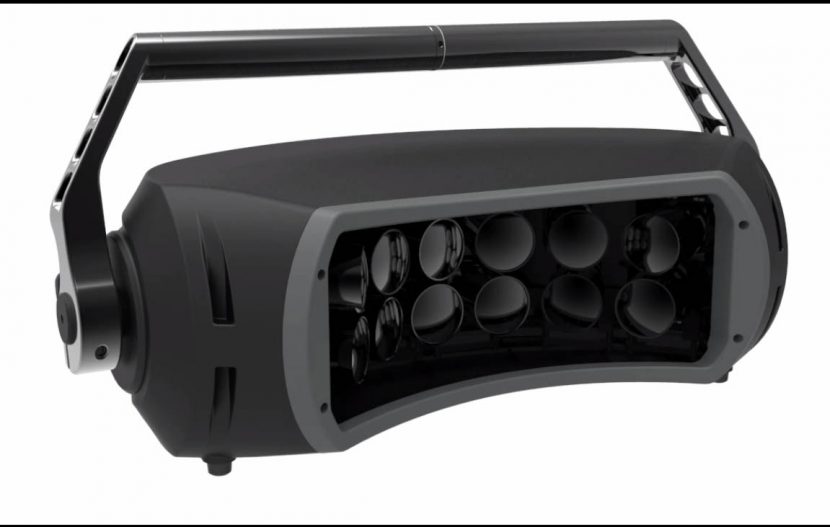
Below is a video explaining the concept.
(*We also noted the graphics from the Promo looked like someone at the Israeli technology startup Pixellot had done our fxphd Flame course 😉 Glad to see they are using our training techniques for good use!)
Away from the Cameras
There is also some big news away from the cameras from The Foundry, and Autodesk, Flame and the new 3ds Max 2016.
Monday night is the Flame users group so we will have more from NAB and in particular the post and vfx tools coming up later in the week.
